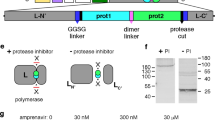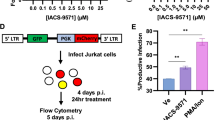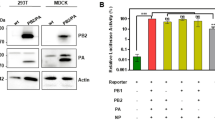Abstract
Small interfering RNA (siRNA) mediates sequence-specific RNA cleavage and represents a potential approach to treat the infection of human immunodeficiency virus (HIV). Expression of a single siRNA species frequently led to the emergence of HIV escape variants. Thus, multiple siRNAs targeted to different regions in the HIV-1 genome may be required. However, overexpression of different anti-HIV siRNA genes from multiple pol III promoters can induce cell toxicity, thus may not be a viable option in the setting of human gene therapy trials. In the current study, we evaluated the strategy of using pol II promoters to drive the expression of siRNAs against HIV-1. We replaced the stem sequence in the stem-loop structure of the well-characterized miR-30a with siRNA sequences and showed that designed microRNA (miRNA) could be expressed from pol II promoters. We demonstrated efficient inhibition of HIV-1 replication with such designed miRNA, but the efficacy was directly correlated with the expression level. Both the vector copy number and the promoter strength directly affected the ability of the siRNA to inhibit HIV-1 replication. We also showed that a combination of pol II and pol III promoters to express two different siRNAs increased the efficacy against HIV-1 replication without comprising cell viability.
This is a preview of subscription content, access via your institution
Access options
Subscribe to this journal
Receive 12 print issues and online access
$259.00 per year
only $21.58 per issue
Buy this article
- Purchase on Springer Link
- Instant access to full article PDF
Prices may be subject to local taxes which are calculated during checkout





Similar content being viewed by others
References
Hannon GJ . RNA interference. Nature 2002; 418: 244–251.
Fire A, Xu S, Montgomery MK, Kostas SA, Driver SE, Mello CC . Potent and specific genetic interference by double-stranded RNA in Caenorhabditis elegans. Nature 1998; 391: 806–811.
Elbashir SM, Harborth J, Lendeckel W, Yalcin A, Weber K, Tuschl T . Duplexes of 21-nucleotide RNAs mediate RNA interference in cultured mammalian cells. Nature 2001; 411: 494–498.
Anderson J, Akkina R . CXCR4 and CCR5 shRNA transgenic CD34+ cell derived macrophages are functionally normal and resist HIV-1 infection. Retrovirology 2005; 2: 53.
Li MJ, Bauer G, Michienzi A, Yee JK, Lee NS, Kim J et al. Inhibition of HIV-1 infection by lentiviral vectors expressing Pol III-promoted anti-HIV RNAs. Mol Ther 2003; 8: 196–206.
Li MJ, Kim J, Li S, Zaia J, Yee JK, Anderson J et al. Long-term inhibition of HIV-1 infection in primary hematopoietic cells by lentiviral vector delivery of a triple combination of anti-HIV shRNA, anti-CCR5 ribozyme, and a nucleolar-localizing TAR decoy. Mol Ther 2005; 12: 900–909.
Hutvagner G, McLachlan J, Psaquinelli AE, Balint E, Tuschl T, Zamore PD . A cellular function for the RNA-interference enzyme Dicer in the maturation of the let-7 small temporal RNA. Science 2001; 293: 834–838.
Bernstein E, Caudy AA, Hammond SM, Hannon GJ . Role for a bidentate ribonuclease in the initiation step of RNA interference. Nature 2001; 409: 363–366.
Grishok A, Pasquinelli AE, Conte D, Li N, Parrish S, Ha I et al. Genes and mechanisms related to RNA interference regulate expression of the small temporal RNAs that control C. elegans developmental timing. Cell 2001; 106: 23–34.
Ketting RF, Fischer SE, Bernstein E, Sijen T, Hannon GJ, Plasterk RH . Dicer functions in RNA interference and in synthesis of small RNA involved in developmental timing in C. elegans. Genes Dev 2001; 15: 2654–2659.
Knight SW, Bass BL . A role for the RNase III enzyme DCR-1 in RNA interference and germ line development in Caenorhabditis elegans. Science 2001; 293: 2269–2271.
Qin XF, An DS, Chen IS, Baltimore D . Inhibiting HIV-1 infection in human T cells by lentiviral-mediated delivery of small interfering RNA against CCR5. Proc Natl Acad Sci USA 2003; 100: 183–188.
Das AT, Brummelkamp TR, Westerhout EM, Vink M, Madiredjo M, Bernards R et al. Human immunodeficiency virus type 1 escapes from RNA interference-mediated inhibition. J Virol 2004; 78: 2601–2605.
Song E, Lee SK, Dykxhoorn DM, Novina C, Zhang D, Crawford K et al. Sustained small interfering RNA-mediated human immunodeficiency virus type 1 inhibition in primary macrophages. J Virol 2003; 77: 7174–7181.
Boden D, Pusch O, Lee F, Tucker L, Ramratnam B . Human immunodeficiency virus type 1 escape from RNA interference. J Virol 2003; 77: 11531–11535.
Novina CD, Murray MF, Dykxhoorn DM, Beresford PJ, Riess J, Lee SK et al. siRNA-directed inhibition of HIV-1 infection. Nat Med 2002; 8: 681–686.
Jacque JM, Triques K, Stevenson M . Modulation of HIV-1 replication by RNA interference. Nature 2002; 418: 435–438.
Tazi J, Forne T, Jeanteur P, Cathala G, Brunel C . Mammalian U6 small nuclear RNA undergoes 3′ end modifications within the spliceosome. Mol Cell Biol 1993; 13: 1641–1650.
An DS, Qin FX, Auyeung VC, Mao SH, Kung SK, Baltimore D et al. Optimization and functional effects of stable short hairpin RNA expression in primary human lymphocytes via lentiviral vectors. Mol Ther 2006; 14: 494–504.
Grimm D, Streetz KL, Jopling CL, Storm TA, Pandey K, Davis CR et al. Fatality in mice due to oversaturation of cellular microRNA/short hairpin RNA pathways. Nature 2006; 441: 537–541.
Bartel DP . MicroRNAs: genomics, biogenesis, mechanism, and function. Cell 2004; 116: 281–297.
Yi R, Doehle BP, Qin Y, Macara IG, Cullen BR . Overexpression of exportin 5 enhances RNA interference mediated by short hairpin RNAs and microRNAs. RNA 2005; 11: 220–226.
Jackson AL, Linsley PS . Noise amidst the silence: off-target effects of siRNAs? Trends Genet 2004; 20: 521–524.
Zeng Y, Wagner EJ, Cullen BR . Both natural and designed micro RNAs can inhibit the expression of cognate mRNAs when expressed in human cells. Mol Cell 2002; 9: 1327–1333.
Stegmeier F, Hu G, Rickles RJ, Hannon GJ, Elledge SJ . A lentiviral microRNA-based system for single-copy polymerase II-regulated RNA interference in mammalian cells. Proc Natl Acad Sci USA 2005; 102: 13212–13217.
Yam PY, Li S, Wu J, Hu J, Zaia JA, Yee JK . Design of HIV vectors for efficient gene delivery into human hematopoietic cells. Mol Ther 2002; 5: 479–484.
Yam P, Jensen M, Akkina R, Anderson J, Villacres MC, Wu J et al. Ex vivo selection and expansion of cells based on expression of a mutated inosine monophosphate dehydrogenase 2 after HIV vector transduction: effects on lymphocytes, monocytes, and CD34+ stem cells. Mol Ther 2006; 14: 236–244.
Reynolds A, Leake D, Boese Q, Scaringe S, Marshall WS, Khvorova A . Rational siRNA design for RNA interference. Nat Biotechnol 2004; 22: 326–330.
Kimpton J, Emerman M . Detection of replication-competent and pseudotyped human immunodeficiency virus with a sensitive cell line on the basis of activation of an integrated beta-galactosidase gene. J Virol 1992; 66: 2232–2239.
Ter Brake O, Konstantinova P, Ceylan M, Berkhout B . Silencing of HIV-1 with RNA interference: a multiple shRNA approach. Mol Ther 2006; 14: 883–892.
Baum C, von Kalle C . Gene therapy targeting hematopoietic cells: better not leave it to chance. Acta Haematol 2003; 110: 107–109.
Baum C, von Kalle C, Staal FJ, Li Z, Fehse B, Schmidt M et al. Chance or necessity? Insertional mutagenesis in gene therapy and its consequences. Mol Ther 2004; 9: 5–13.
Serfling E, Avots A, Neumann M . The architecture of the interleukin-2 promoter: a reflection of T lymphocyte activation. Biochim Biophys Acta 1995; 1263: 181–200.
Ott M, Emiliani S, Van Lint C, Herbein G, Lovett J, Chirmule N et al. Immune hyperactivation of HIV-1-infected T cells mediated by Tat and the CD28 pathway. Science 1997; 275: 1481–1485.
Schroder O, Geiduschek EP, Kassavetis GA . A single-stranded promoter for RNA polymerase III. Proc Natl Acad Sci USA 2003; 100: 934–939.
Graham FL, van der Eb AJ . A new technique for the assay of infectivity of human adenovirus 5 DNA. Virology 1973; 52: 456–467.
Gasmi M, Glynn J, Jin MJ, Jolly DJ, Yee JK, Chen ST . Requirements for efficient production and transduction of human immunodeficiency virus type 1-based vectors. J Virol 1999; 73: 1828–1834.
Acknowledgements
This work was supported by NIH Grant P01A146030 and a grant from UARP of the University of California. We also thank the flow cytometry core and the sequencing core at COH for their help in analyzing the samples.
Author information
Authors and Affiliations
Corresponding author
Rights and permissions
About this article
Cite this article
Lo, HL., Chang, T., Yam, P. et al. Inhibition of HIV-1 replication with designed miRNAs expressed from RNA polymerase II promoters. Gene Ther 14, 1503–1512 (2007). https://doi.org/10.1038/sj.gt.3303011
Received:
Revised:
Accepted:
Published:
Issue Date:
DOI: https://doi.org/10.1038/sj.gt.3303011



